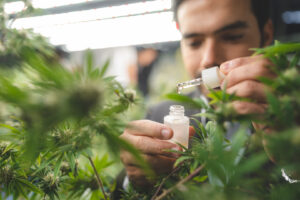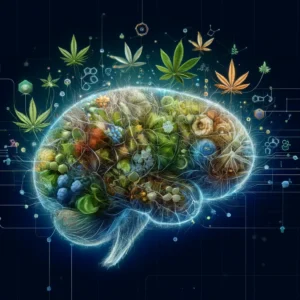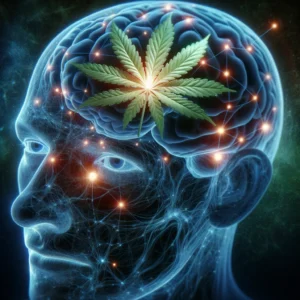Cannabis and Epilepsy: Exploring a Controversial Treatment Frontier
 For centuries, epilepsy’s enigmatic seizures have confounded individuals, doctors, and researchers alike. A neurological disorder characterized by unpredictable interruptions in brain activity, epilepsy is not a condition to be taken lightly. The ills of seizures extend beyond their immediate physical effects — they disrupt lives, shattering the fragile everyday structures that we all depend on. Until now, the approach to treating epilepsy has been rich in its history, laden with complex medications and invasive interventions. However, recent whispers and burgeoning research suggest that a once-shunned substance may hold the key to seismic shifts in epilepsy care — cannabis.
For centuries, epilepsy’s enigmatic seizures have confounded individuals, doctors, and researchers alike. A neurological disorder characterized by unpredictable interruptions in brain activity, epilepsy is not a condition to be taken lightly. The ills of seizures extend beyond their immediate physical effects — they disrupt lives, shattering the fragile everyday structures that we all depend on. Until now, the approach to treating epilepsy has been rich in its history, laden with complex medications and invasive interventions. However, recent whispers and burgeoning research suggest that a once-shunned substance may hold the key to seismic shifts in epilepsy care — cannabis.
Epilepsy’s prevalence — an estimated 50 million people worldwide — makes the need for reliable treatments all the more pressing. In this comprehensive exploration, we’ll dissect the connections between cannabis, its constituent cannabinoids, and the treatment of epilepsy. Our disassembly will lead to scientific revelations, discussions on legality, patient stories, and a gaze into the bright and hopeful yet still relatively shadowy future of cannabis as an epilepsy remedy.
Understanding Epilepsy and Seizures
Before venturing into the green-lit corridors of medicinal cannabis, it’s imperative to understand epilepsy and the ripples of each seizure. Epilepsy, a catchall term for a group of related disorders where the tendency for recurrent seizures is present, can be brought on by myriad factors, including genetics, brain trauma, or infections.
Seizures, as the most visible symptom of epilepsy, are an electrical storm within the brain, leading to varied manifestations from loss of awareness to convulsions. The impact of epilepsy reaches beyond the individual, often dramatically affecting families and communities.
The Anatomy of Cannabis
Cannabis, often spoken about in hushed tones due to its recreational use, is a plant steeped in controversy. Within its delicate leaves and flowering buds lie over 100 different chemical compounds called cannabinoids. Two, in particular, have stolen the limelight in the epilepsy treatment narrative — cannabidiol (CBD) and tetrahydrocannabinol (THC).
CBD and THC: A Delicate Balance
While THC reigns supreme in the recreational domain due to its psychoactive effects, CBD emerges as the genteel giant in the therapeutic arena. CBD, unlike its mischievous cousin THC, does not cause a high. Rather, it has garnered attention for its potential anti-seizure properties.
Scientific Evidence
The discussion around cannabis as a reliable epilepsy treatment is not without supporting data. Over the past decade, research studies and clinical trials have provided tantalizing hints of the benefits CBD can offer to those grappling with uncontrolled seizures.
The Clinical Codex: Evidence in Support
Landmark studies and trials have demonstrated that CBD, when used as an adjunctive therapy, can significantly reduce seizure frequency in some forms of epilepsy, particularly in conditions that have been historically resistant to other treatments.
Anecdotal Atlas: Patient Success Stories
Beyond the sterile walls of laboratories and the rigorous protocols of clinical trials, there exist countless tales of patients whose lives have been transformed by cannabis. A whisper of CBD oil here, a tincture of THC there — these anecdotes underscore the need for more robust research while offering rays of hope to a community desperate for relief.
FDA Approval and Drug Development
The potency of cannabis as a therapeutic agent was solidified with the development and approval of Epidiolex, a CBD-based oral solution. The US Food and Drug Administration’s (FDA) stamp of approval was a watershed moment, paving the way for cannabis-derived medications to enter the mainstream of epilepsy care.
Path to Approval: The Epidiolex Saga
Tracing the arduous path that Epidiolex traversed — from the hazy shadows of controlled substances to the bright promise of controlled medication — provides valuable insight into the challenges and triumphs of cannabis drug development.
Shifting Paradigms: Impact on Perception
The green light for Epidiolex did more than just introduce a new medication; it prompted a seismic shift in the perception of cannabis as medicine. Doctors and patients alike began to reevaluate their stances, opening their minds to the possibilities cannabis might present.
Pros and Cons of Using Cannabis for Epilepsy
Cannabis’s potential to tame the tempest of seizures is undeniably powerful, but it’s a double-edged sword. The benefits are tempered with the potential for misuse and a range of side effects that demand respect.
The Shadow of Side Effects
While CBD boasts a favorable side-effect profile compared to traditional anti-epileptic drugs, it’s not immune to causative factors such as fatigue, lethargy, or liver problems. The debate on long-term effects is ongoing, especially within the pediatric epilepsy population.
The Cauldron of Controversy
Amid the clamor of success stories, a cloud of controversy hovers, especially concerning the use of cannabis in children. The delicate neurodevelopmental balance of the young calls for caution and comprehensive risk assessments before leaping onto the cannabis bandwagon.
Legal and Regulatory Considerations
The palimpsest of legality and regulation painted across the canvas of cannabis use for epilepsy is complex and regionally diverse. From the red tapes of prescription fulfillment to the green pastures of home cultivation, navigating the legalities can be as tricky as diagnosing epilepsy itself.
The Labyrinth of Legalization
While some jurisdictions have opened the gates, allowing for the medicinal use of cannabis, others remain resolutely shut, trapping patients in a web of prohibition. The evolving landscape of cannabis legislation necessitates vigilance and understanding from all stakeholders involved.
Regulation and Quality Control
With the stampede toward cannabis, the importance of regulation and quality control becomes paramount. The vagaries of unregulated markets pose a significant risk to patients, amplifying the importance of standardization and oversight.
Guidelines for Cannabis Use
For those considering cannabis as an epilepsy warrior, a roadmap peppered with guidelines crafted by healthcare providers is essential to ensure safe and effective navigation. From dosing regimes tailored to individual needs to the selection of appropriate administration methods, there’s both an art and a science to using cannabis as medicine.
The Compass Points: Dosing and Administration
Finding the right dosage is an art form that requires patience and iteration. Capsules, oils, or vaporization — the chosen method of administration can influence effectiveness and side effects, making informed decisions a critical step.
Professional Navigation
No treatment should be embarked upon without the guidance of a healthcare professional. Patients and their families must be engaged partners in the treatment decision-making process, armed with information and advocacy.
Future Research and Outlook
The canvas of cannabis as an epilepsy therapy is incomplete. Blank spaces of unanswered questions — the long-term effects, interaction with other drugs, or the synthetization of targeted cannabinoids — beckon for the brushstrokes of future research.
The Mosaic of the Future
The clarion call for more extensive and robust research is only growing louder. The mosaic of the future presents a promising yet murky blend of potential, challenges, and unknowns that demand bold exploration and rigorous scientific inquiry.
Hope on the Horizon
Despite the unknowns, the horizon holds great hope. Continued advancements in understanding the endocannabinoid system and the efforts of researchers worldwide paint a picture of a future brighter with the possibilities of cannabis-based epilepsy therapies.
Conclusion
The conversation around cannabis as an epilepsy treatment is one of controversy, complexity, and compassion. While the road to recognizing cannabis as a vital tool in the epilepsy treatment arsenal is paved with challenges, the potential benefits for those living with uncontrolled seizures are as vast as the fields of hemp. Cannabis, with its potent cannabinoids, stands poised on the precipice of defining a new era of epilepsy care — an era marked by a convergence of traditional medicine and alternative therapies, science, and compassion. For patients and their families, for healthcare providers, and for society at large, the unfolding tale of cannabis in epilepsy is one of great anticipation, tempered with the wisdom of understanding and the cautious optimism of the scientist and the advocate. The story is far from over, but each chapter written brings us closer to a future where epilepsy may no longer hold lives hostage, and where cannabis might be ordained as its liberator.









